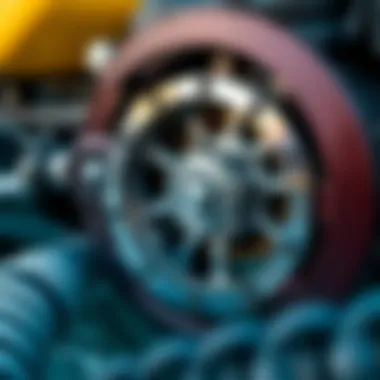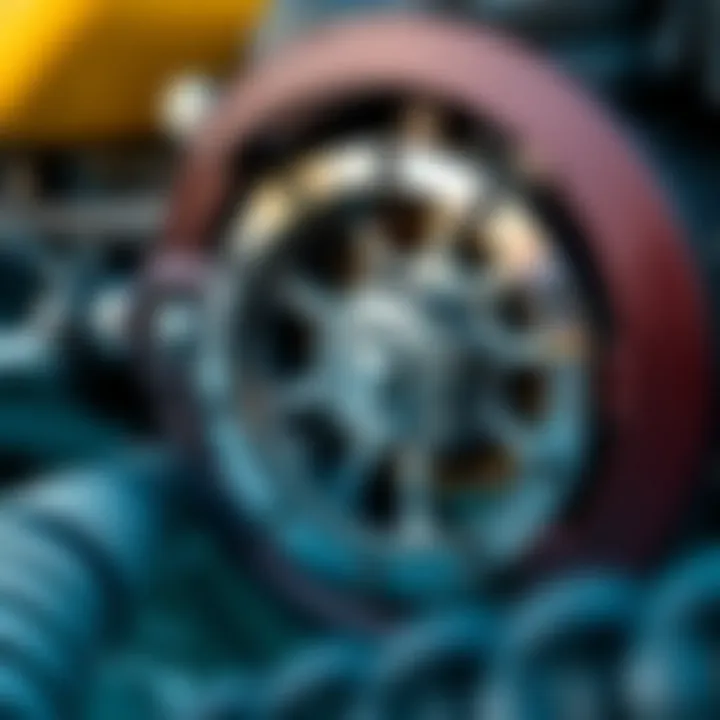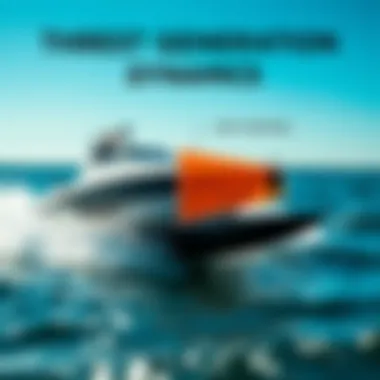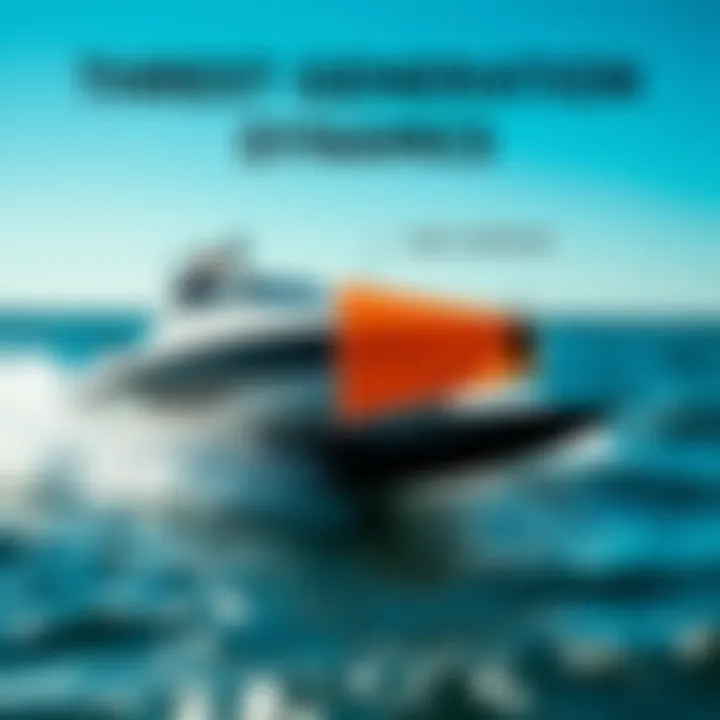Understanding Thrusters: Design and Functionality


Intro
Navigating the watersports landscape requires knowledge, skill, and the right equipment. Among the many tools available, thrusters stand out for their ability to elevate performance and maneuverability. Many enthusiasts may have encountered thrusters in various forms; however, understanding their design and functionality is critical. This article delves deep into thrusters, exploring how they generate thrust and their implications for different water activities. Whether you are a seasoned athlete or a weekend recreationist, knowing the ins and outs of thruster technology can greatly enhance your aquatic experiences.
Expert Insights
Latest Trends in Watersports
Watersport enthusiasts are witnessing exciting innovations that make the experience more enjoyable and accessible. As thruster technology evolves, users can expect numerous advancements, particularly in electric propulsion systems. Increasingly, core manufacturers are favoring eco-friendly solutions that deliver high performance while reducing environmental impact. This move aligns with a broader trend towards sustainability in sports, encouraging more people to engage without compromising nature.
Another promising trend is the customization of thrusters. More brands are offering tailored configurations based on skill level, intended use, and vehicle characteristics. This allows athletes, trainers, and enthusiasts to customize their setups for specific water conditions, which enhances both safety and performance.
Safety Protocols and Best Practices
Safety in watersports cannot be understated. Thrusters, while highly beneficial, must be used correctly to prevent accidents. Here are some essential protocols:
- Pre-Use Inspection: Always conduct a thorough check of your equipment before hitting the water. Look over the thruster components for wear or damage.
- Know Your Limits: Understand your own skill level and the capabilities of your equipment to avoid pushing boundaries unnecessarily. Thrusters amplify speed and mobility, which can lead to risky situations if not managed wisely.
- Wear Appropriate Safety Gear: Personal flotation devices (PFDs), helmets, and impact vests can protect against potential injuries in case of falls or collisions.
"Understanding how to use the thruster effectively can be the difference between a delightful adventure and a dangerous misstep."
Familiarity with the local environment also plays a significant role in safety protocols. River currents, wind conditions, and marine wildlife all present factors that need to be taken into account.
Equipment Recommendations
Must-Have Gear for Beginners
For those just starting their journey in watersports, selecting the right equipment is critical. Here are some essentials that newcomers should consider:
- Entry-Level Thrusters: Look for options that offer decent thrust without overwhelming beginners. Brands such as JetBlades and WaterHovercraft have excellent entry-level models.
- Comfortable Footwear: Proper footwear is vital for grip and support, especially for activities like kite surfing or wakeboarding.
- Basic Safety Equipment: Never venture out without a reliable life jacket and safety line.
Advanced Equipment for Pros
As you gain experience, upgrading to advanced gear can further enhance your performance. Recommendations include:
- High-Performance Thrusters: Brands like LiftFoil offer cutting-edge thrusters that provide exceptional power and control for experienced users.
- Hydrodynamic Accessories: Consider adding fins or stabilizers that optimize maneuverability and help maintain speed.
- GPS and Smart Devices: Tracking devices can help monitor performance metrics, ensuring that you can refine your techniques over time.
By investing in the right equipment, athletes not only increase their efficiency in the water but also contribute to a better overall sporting experience. Understandably, some pieces may be more expensive, but they can serve as long-term assets to maximize enjoyment and safety.
Finale
For further information on thruster technology and watersports, you may want to check out resources from Wikipedia, Britannica, or engage with Reddit communities. Each offers a wealth of knowledge for both enthusiasts and professionals alike.
The Basics of Thrusters
Understanding the core principles behind thrusters is crucial for anyone involved in watersports. Thrusters not only enhance performance but also provide better maneuverability in various aquatic conditions. This section serves as a foundation, shedding light on crucial elements, their benefits, and essential considerations when dealing with thruster systems.
Definition and Functionality
Thrusters are devices designed to propel vessels through water, offering direction and acceleration. These units convert energy into thrust, allowing boats or other aquatic vehicles to navigate with improved precision. The function of a thruster hinges on its design, typically revolving around the principles of fluid dynamics. When activated, these mechanisms generate a flow of water, pushing against the surrounding liquid to create forward (or lateral) movement.
In practical terms, a thruster can be used for various applications, including stabilizing a boat during docking, facilitating controlled movement in tight spaces, or even enhancing speed in racing scenarios. The strength and efficiency of thrusters can significantly affect a sportsman's experience on the water, making their understanding paramount.
Key Points:
- Thrusters provide propulsion and enhance control.
- Their function is based on fluid dynamics principles.
- They allow better navigation, especially in confined spaces.
Historical Development
The evolution of thrusters reflects advancements in both engineering and understanding of hydrodynamics. Historically, the concept of propulsion in water transport has been around for centuries, but the specific design and technology of thrusters have transformed markedly over time.
In the early days, simple oars or sails dictated movement across water bodies. However, as maritime technology advanced, engines came into play, leading to the development of more sophisticated propulsive systems. By the mid-20th century, innovations in materials and hydrodynamic theory facilitated the birth of various thruster types.
For instance, in recent decades, electric thrusters started gaining traction due to their quieter operation and enhanced efficiency. Advances in battery technology also mean that these thrusters can work longer hours without requiring substantial power, appealing to eco-conscious athletes.
“The history of thrusters is a testament to human ingenuity, showcasing how each step forward in technology can lead to a completely new way of enjoying our waters.”
Timeline of Development:
- Early propulsion methods: oars and sails.
- Rise of engine-driven boats: early 20th century.
- Introduction of electric thrusters: late 20th century.
- Emphasis on eco-friendly technologies: early 21st century.
Understanding these fundamental aspects of thrusters is essential not only for their functional significance but also to appreciate the historical journey that has shaped the modern aquatic experience. Knowing how thrusters have developed over time prepares an athlete or enthusiast to make informed choices regarding equipment and techniques, enabling them to harness the full potential of this technology.
Types of Thrusters
Understanding the various types of thrusters is essential for anyone interested in optimizing performance in watersports. This section examines the three primary categories: Electric, Hydraulic, and Mechanical Thrusters. Each type brings unique advantages and considerations that can impact not only the user experience but also environmental implications and operational costs.


Electric Thrusters
Electric thrusters have gained traction due to their efficiency and relatively straightforward installation process. They're powered by electric motors, which provide cleaner and quieter operation compared to their fuel-based counterparts.
- Advantages:
- Eco-friendly: Since they rely on electricity, they produce no emissions when in use, making them ideal for environmentally-conscious users.
- Low Maintenance: Electric systems typically require less maintenance compared to more complex mechanical systems.
- Quiet Operation: Many users find the silent functioning of electric thrusters beneficial for activities such as kayaking or paddleboarding, where the noise could scare away wildlife or disturb the calm of the water.
However, a reliable power source is critical. Users may need to consider battery capacity, charging options, and stall time when planning outings. Moreover, the dependency on electricity limits their operational time, depending on battery life.
Hydraulic Thrusters
Hydraulic thrusters operate on oil and gain their power through hydraulic pressure. They’re renowned for their robust performance, delivering significant thrust effectively.
- Advantages:
- Powerful Thrust Generation: These systems excel in pushing larger watercraft or when high thrust is needed instantly.
- Durable: Hydraulic thrusters are often built to withstand harsh marine conditions, which can make them a solid choice for professional watersports.
- Fine Control: They offer refined control over thrust direction and intensity, enabling precise maneuverability in challenging waters.
Nevertheless, hydraulic systems can be expensive upfront and may require more maintenance, with potential oil leaks being a concern.
Mechanical Thrusters
Last but not least are mechanical thrusters, which are fundamentally driven by mechanical means—often a propeller system generated by a combustion engine or other mechanical force. They are commonly found in traditional watercraft.
- Advantages:
- Reliability: Mechanical thrusters can be less dependent on electrical or hydraulic systems, offering users a more reliable option in terms of thrust generation.
- Ease of Repair: Many mechanical components are intuitive to repair or replace, fostering ease of maintenance in emergency situations.
- Variety of Applications: These thrusters cater to a broad range of uses, from motorboats to large vessels, making them versatile.
On the flip side, they can be less efficient and generally contribute more noise and pollution compared to electric thrusters. Users may need to balance the reliability and versatility of mechanical thrusters with considerations around operational efficiency and environmental impact.
Key Takeaway: Each of these thruster types serves a distinct purpose in the realm of watersports, from eco-friendly electric thrusters to rugged hydraulic designs and reliable mechanical systems. The choice really depends on specific needs and preferences, whether one is seeking sustainability, power, or ease of maintenance.
Key Components of a Thruster System
The functionality and efficiency of a thruster system hinge on various essential components. Each plays a pivotal role in not just how the device operates, but also in how it enhances performance in the diverse realm of watersports. Understanding these key components allows athletes and enthusiasts alike to appreciate the intricate mechanics that drive their equipment.
Propellers and Blades
At the heart of any thruster lies its propellers and blades. These components are crucial, as they generate the thrust needed to propel vessels through the water. When designing a thruster, the shape and material of the propellers can drastically affect performance. Common materials include robust plastics or lightweight metals that resist corrosion and wear.
A well-designed blade shape optimizes water flow, creating greater lift and minimizing drag. For instance, variable pitch blades allow for changing angles, adapting to various conditions for enhanced efficiency. In visceral terms, it’s like having an athlete who can adjust their stride to tackle any terrain—each blade flexibility empowers better navigation through water.
"The beauty of propeller design lies in its balance—too much pitch, and you’re left grinding through water, too little, and you’ll find yourself barely moving."
Power Supply Options
Next, the choice of power supply options dictates the performance sustainability of thruster systems. From traditional combustion engines to cutting-edge electric systems, the power source impacts thrust output and control. Electric thrusters, for example, offer quiet operation and fewer emissions, which appeals to eco-conscious water enthusiasts. However, they may not always deliver the sheer power of a gasoline engine in demanding conditions.
Another consideration is battery life for electric options. The balance between weight, storage capacity, and output is a fine dance. Imagine being on an extended trip where your thruster battery dies midway; careful selection of the power supply can mean the difference between an unforgettable day on the water or a frustrating swim back. Choosing the right power supply is critical in optimizing performance and ensuring that the thrill of the sport is maximized.
Control Mechanisms
Lastly, the control mechanisms of a thruster system allow users to interact with their equipment effectively. These can range from simple manual levers to sophisticated electronic controls, each offering different levels of precision. High-tech controls enable adjustments in real time, which can be vital during competitions or in rough conditions.
The responsiveness of the control system not only affects maneuverability but also influences the overall safety of the operator. With a more advanced control mechanism, operators can execute intricate maneuvers that respond effectively to changes in conditions. For instance, when catching a wave, being able to control the thruster’s output can mean the difference between crashing ungracefully or gliding smoothly.
How Thrusters Improve Performance
The significance of thrusters in watersports cannot be overstated, as they play a crucial role in enhancing performance across various aquatic activities. Properly integrated thruster systems facilitate control and agility, making it easier for participants, whether enthusiasts or professionals, to achieve their desired performance levels. Let's delve into the specific ways thrusters improve maneuverability, stabilize vessels in challenging conditions, and enhance fuel efficiency—all vital aspects contributing to an exceptional watersport experience.
Enhanced Maneuverability
One of the primary benefits of thrusters is the enhanced maneuverability they offer. With the right thruster setup, kayakers, surfers, and other water adventurers can execute sharp turns and intricate maneuvers that would otherwise be difficult. As thrusters create additional thrust in specific directions, this allows paddlers to control their movement accurately even in turbulent waters.
For instance, a surfboard outfitted with a thruster system can quickly respond to the shifting waves and currents, making it easier for the rider to maintain balance while navigating tricky conditions. This level of precision is particularly advantageous in competitive scenarios where an athlete's success often hinges on those critical moments of agility. High-performance machines, like the Paddle Surf Thruster, provide a distinctive edge by allowing riders to carve into waves with greater finesse.
Stability in Challenging Conditions
Stability in rough waters is another remarkable attribute imparted by thrusters. Whether it's strong winds or unpredictable waves, a well-positioned thruster system can prevent lack of control during voyages. For example, a priority concern for kayak fishermen is maintaining balance while casting. Thrusters help maintain stability by counteracting the tilting caused by waves and helping the kayak remain upright.
"Thrusters provide balance where nature may want to throw you off your game."
Moreover, the distributed thrust along the longitudinal axis of the kayak reduces the risk of capsizing, hence adding a layer of safety. Riders can therefore focus more on enjoying the sport rather than worrying about their craft's stability. In stressful conditions, the assurance of reliability provided by thrusters creates a smoother experience.
Fuel Efficiency Considerations


Lastly, fuel efficiency is a paramount consideration when selecting equipment for water sports. Thrusters can contribute significantly to optimizing fuel usage, leading to longer sessions on the water without overexerting one’s energy reserves.
When it comes to electric thrusters, for instance, many come equipped with energy-efficient designs that maximize thrust while minimizing power consumption. This is especially useful for long-distance sailing or fishing excursions where maintaining a steady pace is essential. Adopting thruster technology can translate into lower operational costs, allowing athletes to spend more time focused on their sport rather than worrying about running low on fuel. Additionally, the installation of thrusters may also lead to less fuel burnt during operation, making them a better option for eco-conscious adventurers.
In summary, thrusters undeniably enhance performance in watersports by improving maneuverability, increasing stability even in choppy waters, and maximizing fuel efficiency. These factors make them an indispensable tool for both novice and experienced enthusiasts alike, contributing to greater enjoyment and success on the water.
Applications in Watersports
Thrusters have become a cornerstone of modern watersports, greatly enhancing the overall experience for participants. Their inclusion not only streamlines maneuverability but also allows for precision control that can make or break a session on the water. With numerous advantages, selecting the right thruster for each specific sport can influence performance tremendously. This section outlines three particular adaptations in surfing, kayaking, and paddleboarding, revealing how technological advancements in thruster design directly impact athletes’ experiences.
Surfing Adaptations
In the world of surfing, thrusters have redefined the way surfers engage with the waves. A thruster setup typically consists of three fins, which distribute paddling power and optimize control. It’s no coincidence that this configuration allows surfers to carve sharper turns and generate quick acceleration. Pros like John John Florence advocate for the thruster setup because it grants them not just stability but agility required to tackle the most demanding surf conditions.
The considerations for surfers are multifaceted:
- Wave Type: A thruster’s efficiency can vary drastically depending on wave shape and size.
- Board Design: The surfboard's dimensions and contouring impact how well a thruster performs. For example, a wider tail may necessitate adjustments on fin size and placement.
- Rider Skill Level: Novice surfers might prefer a more forgiving thruster setup, while experts often opt for higher performance configurations that enhance speed and responsiveness.
Kayaking Innovations
When it comes to kayaking, thruster technology has sparked some innovative changes. Traditional paddling is notoriously physically demanding. Enter the electric thruster, which has transformed recreational kayaking. These systems effortlessly yield greater thrust while minimizing the stress on shoulders and arms. Whether you are navigating calm lakes or white-water rapids, a reliable thruster can vastly improve the efficiency and enjoyment of your journey on the water.
Key aspects for kayakers considering thrusters include:
- Battery Life: A robust battery ensures sustained power during extensive trips, making drain rates a critical consideration.
- Weight Distribution: Proper placement of the thruster in a kayak can modify handling. A balanced kayak will maneuver with ease through unpredictable currents.
- Control Mechanism: For paddlers who enjoy hands-free options, remote controls or foot pedals can significantly enhance the paddling experience.
Paddleboarding Enhancements
Lastly, paddleboarding has seen an infusion of thruster technology that caters to both leisure paddlers and competitive racers alike. Adapting traditional boards with thruster systems permits faster speeds and more effective gliding, allowing enthusiasts to traverse larger bodies of water with ease. Furthermore, the customized fin setups cater to different riding styles - be it touring or racing.
Considerations for paddleboarders include:
- Fin Configuration: The number and shape of fins impact stability versus speed, allowing riders to tailor their boards to their preferences.
- Buoyancy: A properly designed thruster will enhance buoyancy in various water conditions, which is crucial for maintaining speed while racing.
- Portability: Lightweight materials for thruster systems make it easy for paddlers to transport their boards to distant locations.
"Choosing the right thruster is like choosing the right set of tires for a car; it directly affects performance."
In summary, the integration of thruster technology into watersports has revolutionized how enthusiasts interact with their environments. As these technologies continue to evolve, staying informed about the latest innovations is indispensable for all athletes keen on maximizing their aquatic adventures. By understanding the applications of thrusters in surfing, kayaking, and paddleboarding, participants can make educated decisions that enhance performance and enjoyment on the water.
Choosing the Right Thruster
Selecting the appropriate thruster can be the difference betwen a day of harrowing struggle and a smooth sailing experience on the water. Each watersport, be it kayaking, paddleboarding, or surfing, presents unique challenges that require tailored solutions. This section aims to illuminate key factors that affect your thruster choice, marrying technical insights with practical applications.
Assessing Your Needs
Before you even head to the shop or scroll through online options, it’s crucial to understand what you want from a thruster. Think about your activity, skill level, and typical conditions. Are you mostly catching waves at a surf break, or perhaps navigating through calm lakes?
- Skill Level: If you’re a beginner, a simple, user-friendly thruster may be the way to go. An overly complex setup could lead to frustration while you’re still trying to master basic techniques.
- Watersport Type: Different watersports require differing thrust profiles. For roll-heavy paddleboarding days, you might want a compact model that offers precision over raw power.
- Environmental Conditions: Will you often face choppy waters or strong currents? A thruster designed to enhance stability in turbulent conditions could be worth its weight in gold.
Comparing Specifications
With the basics sorted out, it’s time to dive into the nitty-gritty. Manufacturers often present their thrusters with a laundry list of specs that may sound impressive but could be overwhelming if not contextualized.
Key specifications to probe include:
- Thrust Power: Measured in pounds, thrust power indicates how forcefully a thruster can propel you through water. A higher thrust is advantageous in choppy seas but might be overkill for calmer days.
- Size and Weight: Larger or heavier thrusters can offer more stability but may hinder maneuverability. Make sure to balance size with your performance needs.
- Materials: High-grade materials like carbon fiber might add significant durability but also enhance costs. Weighing longevity against expenses will guide your decision.
Utilize comparison charts or spec lists for direct side-by-side evaluations of your shortlisted choices.
Budget Considerations
Investing in a thruster isn't just about the sticker price. There are long-term costs to consider that can sneak up on the unprepared. Established brands often command a premium, but they typically back it with warranties and customer support.
When mapping out your budget:
- Initial Purchase Price: This will likely be your first financial hurdle, but it’s not the whole story. Look for deals, especially during off-peak seasons, to snag better prices.
- Maintenance Costs: Some thrusters require more care than others. For instance, an electric thruster might necessitate frequent battery replacements.
- Resale Value: Depending on the brand and model, some thrusters retain their value, making them a more viable long-term investment.
Overall, be sure to put your financial ducks in a row before making a decision.
"An informed choice can flatten the learning curve and amplify your performance."
In closing, knowing what you need, comparing specs candidly, and thinking about your budget effectively can pave the way for a satisfying purchase. Here’s to finding that perfect thruster – one that complements your journey on the water, elevating every experience to its fullest potential!
Maintenance and Care
Maintaining your thruster is crucial for ensuring efficient performance and longevity. Proper care goes beyond mere functionality; it’s about preserving the investment made in your aquatic adventures. A well-kept thruster can greatly enhance your experience on the water, preventing unexpected mishaps that can ruin an otherwise pleasant day. This section guides you through regular inspections, cleaning techniques, and troubleshooting common issues, all pivotal to optimum thruster upkeep.


Regular Inspections
Conducting regular inspections is the bedrock of thruster maintenance. Think of it like going to the doctor for a check-up; it helps catch potential problems before they escalate. Look for signs of wear, corrosion, or physical damage to components such as the blades and housing. Furthermore, inspect the connections and wiring, as these can become loose or corroded over time.
A thorough inspection checklist includes:
- Visual Examination: Check for any cracks or distortions in the thruster body.
- Wiring Assessment: Look for frayed wires and ensure all connections are secure.
- Functional Testing: Run the thruster to make sure it operates smoothly;
- Corrosion Check: Look for rusty spots, which can indicate that it’s time for some attention.
- Lubrication: Ensure all moving parts are properly lubricated to reduce friction.
Perform these checks at least once a month during active seasons. If you use your equipment less frequently, adapt based on usage. After all, an ounce of prevention is worth a pound of cure.
Cleaning Techniques
When water and salt meet any kind of machinery, cleanliness goes a long way in enhancing performance. Saltwater, algae, and other particles can crystallize and cause damage over time if left unchecked. Here’s how you can keep your thruster in top shape:
- Freshwater Rinse: After every use, especially in saltwater, rinse the thruster with freshwater to wash away any residues. This simple step can prevent corrosion and prolong the lifespan of metal components.
- Detergents: Occasionally, using a mild detergent can help break down stubborn grime. Ensure you rinse thoroughly to remove all cleaning agents, as chemicals may damage seals and gaskets.
- Brush for Tough Spots: A soft bristle brush is your best friend for stubborn areas. It won’t scratch the surface but will help dislodge any adhered debris.
- Regular Maintenance: Consider a periodic deep clean as part of your routine. This can include thorough inspections of all components, lubricating moving parts, and checking seals and O-rings for proper functionality.
Troubleshooting Common Issues
Every piece of equipment is bound to run into hiccups occasionally. Knowing how to troubleshoot can save you time and money. Here are ways to detect and solve typical thruster issues:
- Loss of Power: If you notice a decrease in power, inspect the power supply and ensure connections are tight. Also, check for any blockages in the flow path that may affect thrust.
- Unusual Noises: Grinding or rattling sounds often signal that something is amiss. This could range from loose bolts to worn-out bearings. Addressing this early can stop more serious damage.
- Vibrations: Excessive vibrations may indicate an imbalance or misalignment in the components. Remove the thruster and realign or replace damaged parts as necessary.
- Overheating: If the thruster becomes hot to the touch during operation, it could mean that the bearings are dry or there’s an issue with the electrical system.
In summary, investing time in maintenance and care not only helps your thruster operate at its best but also extends its life considerably. This is especially vital for avid watersports enthusiasts who rely heavily on their equipment. Keeping in mind the importance of regular inspections, effective cleaning techniques, and knowing how to troubleshoot common issues can make your time on the water more enjoyable and hassle-free.
"A well-maintained thruster is like a trusted companion; it will always deliver when you need it the most."
For additional resources on maintenance practices, consider visiting Wikipedia or Britannica. You can also find community support at Reddit.
Future Trends in Thruster Technology
The realm of thruster technology is undergoing rapid transformation. As water sports gain popularity, understanding the future trends in this field becomes paramount for athletes and enthusiasts alike. Not only do these advancements have the potential to revolutionize performance, but they may also address environmental concerns and enhance user experience.
Innovations in Efficiency
Thrusters have come a long way from their traditional designs. One of the key focuses nowadays is efficiency—striving to maximize performance while minimizing energy consumption. New materials, such as lightweight composites, are being utilized to construct thrusters that offer greater propulsion with less drag.
Innovation in propeller design is another area of keen interest. For instance, adapting biomimicry from marine life has led to the creation of more effective blade shapes. This allows for improved thrust at lower power levels, translating into better fuel efficiency for electric and hydraulic thrusters. As the following points demonstrate, there's a lot in store:
- Adaptive Control: Some thrusters are now incorporating responsive blade pitch systems that adjust to real-time conditions, maximizing efficiency automatically.
- Energy Recovery Systems: Technologies that harness energy from the water flow around the thruster are being developed, reducing the overall energy demand.
"The future of thruster technology lies in its ability to evolve alongside the expectations of passionate watersport practitioners."
Eco-Friendly Developments
As the world shifts towards sustainability, thruster technology has not been left behind. Innovations geared towards eco-friendliness are now at the forefront of development strategies. Many manufacturers are prioritizing the use of recyclable materials and energy-efficient operations. Here are a few trends making waves in this regard:
- Alternatives to Traditional Fuels: Electric thrusters powered by renewable energy sources are gaining traction. Some systems utilize solar power or kinetic energy to supplement or replace conventional fuel sources, reducing the carbon footprint.
- Biodiesel and Biofuels: Manufacturers are experimenting with biofuels made from sustainable sources, enhancing combustion efficiency and minimizing pollutants.
Integration with Smart Technologies
The integration of smart technologies into thruster systems is a game-changer. The advent of the Internet of Things (IoT) has allowed for the development of smarter thruster systems that enhance user engagement. Here’s what’s on the horizon:
- Real-Time Monitoring: Advanced sensors within thruster systems provide real-time data on performance metrics. Athletes can gain insights into speed, efficiency, and operational status, enabling better decision-making during practice or competition.
- Mobile Connectivity: Many thruster systems can now connect with mobile applications, offering users remote control functionalities and diagnostic feedback right from their smartphones.
As the industry moves towards smart thruster technologies, users can expect enhanced adaptability and control. Each of these trends indicates a clear direction where convenience, efficiency, and environmental sustainability coexist.
In summary, future trends in thruster technology emphasize efficiency innovations, eco-friendly developments, and smart integrations. Understanding these trends is essential for water sports enthusiasts looking to push the boundaries of performance while remaining mindful of their environmental impact.
Finale
Understanding thruster technology is essential for anyone keen on enhancing their aquatic experiences. The article navigated through the various intricacies of thrusters, illuminating not only their functionalities but also their diverse applications in watersports. By piecing together how thrusters operate, the ways they contribute to performance, and their relevance to safety and enjoyment, readers can gain a more profound appreciation for these devices.
Recap of the Importance of Thrusters
Thrusters serve as more than just propulsion systems; they are vital tools that significantly boost maneuverability, stability, and efficiency in watercraft. Their role becomes even clearer when discussing specific aspects:
- Maneuverability: Thrusters can turn a cumbersome vessel into a nimble entity, allowing athletes to navigate tight spaces with precision. For instance, when a kayaker approaches a narrow bend or a paddle boarder wants to avoid turbulent waters, the agility provided by a well-designed thruster makes the difference.
- Stability: In wavy conditions, the additional thrust can keep a boat on a steady course, thus providing a safer experience for recreationalists and competitive athletes alike. This stability is particularly noticed by surfers who need to maintain balance while riding waves.
- Fuel Efficiency: Modern thrusters are engineered to optimize fuel use, allowing for longer sessions on the water without constant refueling. This advantage appeals to those who partake in lengthy excursions, where every drop of fuel counts.
The discussion surrounding thrusters isn’t merely technical; it directly impacts user experiences.
Final Thoughts for Watersports Enthusiasts
For practitioners, understanding the value that thrusters bring can drastically shape how one interacts with watersports. Here are some considerations:
- Embrace Technology: Keeping an eye on technological advancements can lead to enhanced performances. With innovations such as electric thrusters becoming more prevalent, adopting these new technologies could elevate the entire experience on the water.
- Regular Maintenance is Key: Owning a thruster comes with responsibilities. Regular checks and cleaning are vital to ensure optimal functioning, hinder costly repairs, and prolong the lifespan of the equipment. Ignoring this can lead to disappointing outings.
- Stay Informed: Following forums like those on Reddit or checking educational resources related to watersport equipment can help you stay abreast of user experiences and tips.
To conclude, comprehending the dynamics of thrusters equips athletes, coaches, and casual recreationists with the knowledge to optimize their performance and safety. Whether you are gearing up for a humble kayaking trip or preparing for a high-stakes competition, the right thruster can make all the difference.
"The ocean stirs the heart, inspires the imagination and brings eternal joy to the soul."
Thus, whether you are paddling, surfing, or navigating, taking the plunge into thruster knowledge is a wise choice that can enhance your encounters on the water.







